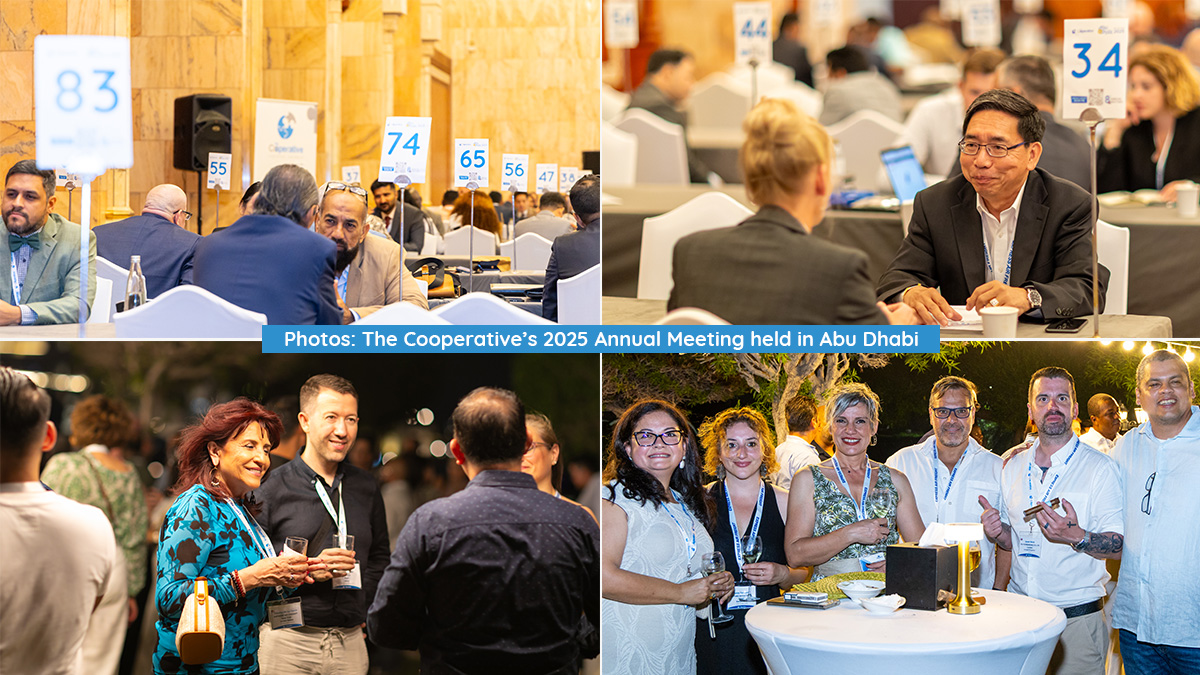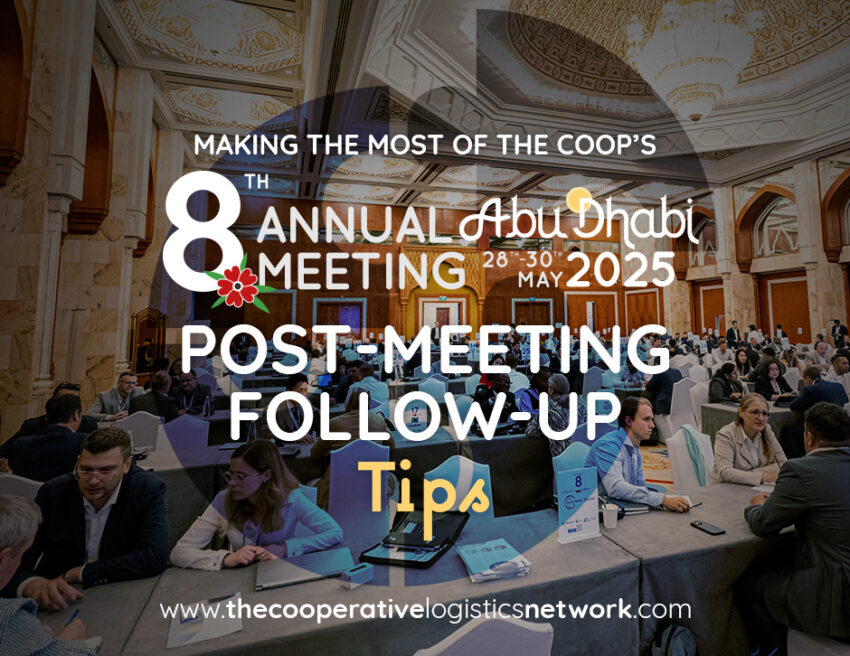The Cooperative Logistics Network’s 8th Annual Meeting, held in Abu Dhabi from 28th to 30th May 2025, has just concluded on a high note. Over 200 independent freight forwarders from around the globe gathered under one roof for three days of networking, learning, and building lasting partnerships. As always, the freight forwarders conference provided members with a golden opportunity to consolidate relationships, discuss collaborative ventures, and gain new business insights. While the energy and momentum of the Annual Meeting were palpable throughout the sessions and one-to-one meetings, the real value of attending such a conference lies in what comes after.
Following up after the meeting is crucial to transforming conversations into collaborations and ideas into real-world shipments. Whether you met five new partners or fifty, your success in the network depends heavily on your ability to keep the dialogue going, nurture new connections, and translate discussions into active freight projects. Here are some essential post-meeting follow-up strategies that every Coop member should consider to get the most return on their investment in attending the Annual Meeting.

Start with a timely and personal follow-up after the freight forwarders conference
Time is of the essence when it comes to post-event communication. Reaching out to the contacts you met within a week of the event keeps the interaction fresh in their memory and signals your genuine interest in collaboration. When writing to a fellow member you met in Abu Dhabi, it’s important to refer to your meeting in a personal and specific way. Mention something memorable you discussed—perhaps a project you explored together or a shared challenge in your respective markets. Personalized messages are far more impactful than generic thank-you notes.
At this stage, your aim should be to reconnect and reinforce the rapport you built during the meeting. Express your appreciation for the discussion, reaffirm your willingness to collaborate, and suggest a time for a follow-up conversation. This can be done over email or, even better, through a quick Zoom or Teams call. A second conversation helps maintain momentum and clarifies the next steps more effectively than endless email chains.
Be clear and considerate when proposing the meeting—offer specific date and time options while keeping time zones in mind. A well-organized follow-up shows that you’re proactive and serious about forming a lasting working relationship. It’s often in these one-on-one calls that real business partnerships begin to take shape.
Organize and prioritize your contacts
During the freight forwarders conference, you likely had several one-to-one meetings—some more promising than others. It is important to organize your new contacts based on relevance, potential, and immediacy. Freight forwarders who serve strategic trade lanes or who expressed strong interest in cooperating with you should be moved to the top of your list. Use a simple spreadsheet or CRM tool to log contact information, discussion highlights, and agreed-upon action points. This will help you stay on top of follow-ups and avoid letting high-potential leads go cold.
Additionally, consider noting the services or strengths each agent offers. For example, if a fellow Coop member based in Turkey mentioned their expertise in customs clearance or e-commerce logistics, having this information at hand will make it easier for you to recall and recommend them when relevant opportunities arise.
Turn discussions into actionable proposals
Many forwarders leave networking events with good intentions but no concrete plans. The difference between a fruitful freight forwarders conference and a forgettable one often comes down to who initiates the first actionable proposal. If you discussed the possibility of routing your Asia-bound shipments through a new partner in Malaysia or collaborating on a door-to-door service in Buenos Aires, now is the time to send a quote request or suggest a pilot project.
Don’t wait for the other party to take the lead. Proactively sharing a test shipment opportunity, inviting your partner to quote on a real consignment, or proposing a co-branded service can all help to cement the relationship and start building mutual trust. Even small projects can serve as stepping stones to larger and more sustained collaborations.
Stay connected on LinkedIn and Facebook with your network partners
In today’s digital landscape, social media is one of the easiest and most effective ways to nurture your professional connections—especially after The Cooperative Logistics Network’s Annual Meeting. Once the event ends, take a moment to connect with the freight forwarders you met on LinkedIn. A brief, personalized message like “Great meeting you at The Coop’s Annual Meeting in Abu Dhabi—looking forward to collaborating!” adds a personal touch and keeps the conversation going.
Don’t stop at LinkedIn—Facebook can be equally valuable. Many freight forwarding companies have active business pages or groups on Facebook where they share updates, industry news, and accomplishments. By following your new contacts’ company pages and engaging with their content—whether through likes or thoughtful comments—you stay on their radar in a friendly and non-intrusive way.
If your company has a Facebook page, consider posting a recap of your experience at The Coop’s Annual Meeting. Tag fellow members or companies where appropriate to highlight your networking efforts and spark engagement. An active presence on both platforms helps you stay visible, approachable, and ready for new business opportunities.
Revisit and share meeting notes with your team
While you may have attended the meeting alone or with a colleague, the benefits of your experience should extend to your entire organization. Sharing your meeting notes, contact lists, and insights with your sales, operations, and pricing teams can help them align with your new partnerships. For instance, if you learned about new warehousing solutions in Durban or faster LCL consolidation services in Shanghai, your team needs to be informed so they can take advantage of those opportunities when needed.
Host a debriefing session to review key takeaways and highlight new partner strengths. This internal alignment ensures that your broader team understands the value of the relationships you’ve built and can incorporate them into daily decision-making, ultimately resulting in a more connected and responsive logistics operation.
Offer value, not just updates
After The Cooperative Logistics Network’s Annual Meeting, your follow-up messages should go beyond just checking in. Instead of a generic “Any update on our conversation?”, try sharing something relevant and useful. For example, you could send a case study, a digital brochure highlighting your services in a particular region, or an article on logistics trends or trade developments that may impact their operations.
By offering something of value, you demonstrate that you’re thinking about their business, not just your own. This approach positions you as a knowledgeable and thoughtful partner, and shifts the relationship from transactional to collaborative. Coop members appreciate working with peers who bring insights and support, not just sales pitches.
Build trust through transparency and consistent communication
In the freight forwarding industry, trust is built through consistent performance and clear communication. Once you’ve initiated a conversation or proposed a collaboration, it is critical to follow through. If a partner sends you a quotation request or shipment proposal, be sure to respond in a timely and professional manner. If you’re unable to meet a request or face internal challenges, communicate openly rather than going silent.
Even if your first collaboration with a new partner doesn’t result in immediate business, staying communicative shows reliability. Regular check-ins, sharing market updates, or simply staying in touch via email can help reinforce your relationship until the right project emerges. Strong communication habits make you a more attractive partner and increase the likelihood of referrals and reciprocal business.
Track results and celebrate collaborative success
Over time, the success of your Annual Meeting participation can be measured by the collaborations it generates. Whether it’s a cross-trade shipment, a new warehousing partner, or a long-term shipping contract, it’s important to track your wins and recognize their origin in the Annual Meeting. This not only helps justify the investment of attending future events but also reinforces the value of The Cooperative Logistics Network’s exclusive environment.
When you complete a successful shipment with a fellow member, consider sharing your experience with The Coop team. Such success stories can be featured on the Coop’s blog or newsletter, giving both partners additional visibility. Celebrating achievements together strengthens your position within the network and motivates further cooperation.
Looking ahead: Keep the momentum going
The end of the freight forwarders conference is only the beginning of the relationship-building journey. While the in-person interactions in Abu Dhabi laid the groundwork, your follow-up efforts will determine the long-term outcomes. Treat every new contact as a potential long-term partner and nurture the connection with dedication and professionalism.
The Cooperative Logistics Network is built on mutual trust, proactive collaboration, and shared growth. By implementing these post-meeting strategies, you’re not only helping your business thrive—you’re also strengthening the network as a whole.
As we close the chapter on the 8th Annual Meeting, let’s carry forward its spirit of cooperation, commitment, and connectivity. Here’s to building stronger, smarter freight forwarding alliances in 2025 and beyond.


